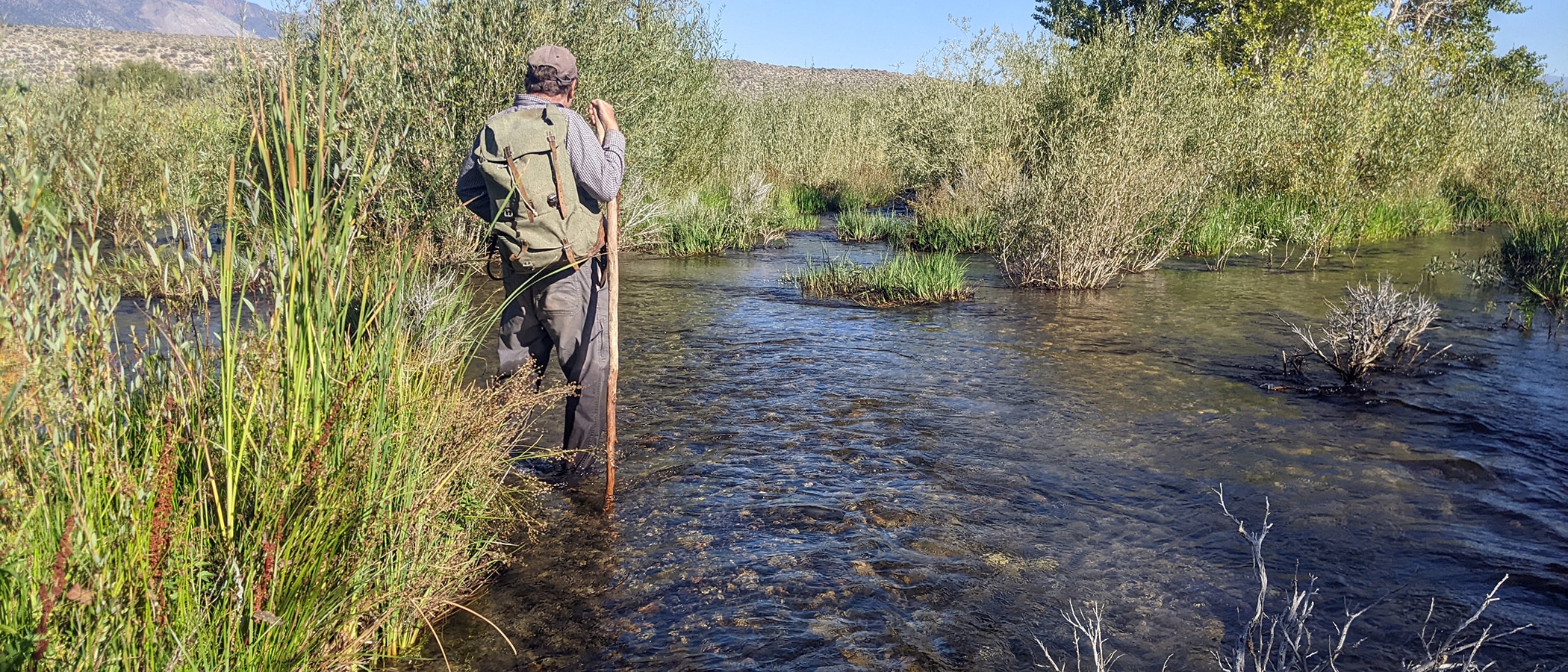
Wet years like 2017 and 2023 produce some of the most exciting restoration outcomes along Mono Lake’s tributaries. The large hydrologic forces during peak flood events in a wet year are unmatched in their ability to move large cobbles, open side channels, inundate floodplains, and reshape a stream system’s structure. Initially in 2011, but most dramatically after the 2017 flood, it became clear there was another ecological process at work on Rush Creek: beavers. Beavers were not part of the pre-diversion 1941 conditions on Rush Creek, but they have locally expanded their range from Lundy Canyon. Their presence on the creek has had promising benefits.
Streambed incision
A clear restoration benefit that beavers provide to the Rush Creek bottomlands is that their dams back up water and keep the water table high. This is particularly valuable where several reaches of the stream suffer from incision caused largely by the artificially low Mono Lake levels of the last eight decades.
As the lake dropped due to excessive water diversions by the Los Angeles Department of Water & Power, streamflow reaching the delta cut down vertically into the streambed, creating deep incision that has since traveled upstream. Incision lowers the water table, making streamside vegetation restoration in historic riparian corridors challenging and, in some cases, impossible. Beaver dams can mitigate streambed incision by stabilizing the channel, backing up water, and raising the height of the surface water and groundwater, all of which allow stream ecosystem processes to occur more as they did before the streambed incision occurred.
Large woody debris
Another clear restoration benefit that beavers provide to the Rush Creek bottomlands is that by building dams out of small-diameter willow stems, they physically bring woody debris into the creek. In-stream woody debris provides valuable habitat to trout while also providing resistance to streamflow that can back up water (like a beaver dam). Since large trees take many decades to grow, and longer to fall into the creek, beavers actively bringing wood into the creek functions like an expedited restoration project.
More complex outcomes
While beaver activity seems to be helping stream restoration in the Rush Creek bottomlands, State Water Board-appointed Stream Monitoring Directors Dr. Bill Trush and Ross Taylor are also studying beaver effects that are perhaps less straightforward. For example, a network of beaver dams caused a major, fast-flowing stream channel to fill with cobbles and dry out after the 2017 flood. Since then, water has been forced into a previously dry side channel, which now stays open year-round and is creating a new network of stream channels and meadow habitat in what was previously sagebrush. Since the 2023 flood event the stream is continuing to favor this new side channel system and dry out other parts of the bottomland ecosystem. In addition, conversion of channels to ponds reduces invertebrate diversity. So, every part of the Rush Creek bottomlands may not benefit equally from beaver activity and some areas may be negatively affected.
Continued monitoring
In 2023 Trush and Taylor worked to better understand the complex ways the stream ecosystem is responding to the presence of beavers. In October, after the peak flows subsided, the two directors stood together, knee-deep in newly formed side channels, surrounded by five-year-old willows and drowned sagebrush. Some things were immediately noticeable, like how these new channels offered refuge to young trout during a season with persistent high flows. Other things were less noticeable, like the water temperatures in this exposed channel system.
The beneficial work of beavers is getting a lot of attention in restoration efforts across the West, and California agencies have even changed policies and reintroduced beavers to help fix degraded habitats in other parts of the state. The Stream Monitoring Directors are studying and monitoring beaver activity in the Mono Basin and the Mono Lake Committee will continue to provide on-the-ground support in this exciting phase of Mono Lake’s tributary stream restoration.
This post was also published as an article in the Winter & Spring 2024 Mono Lake Newsletter. Top photo by Robbie Di Paolo.

I’m thrilled to know beavers are helping out up there! I seriously doubt the negative effects of beavers could ever come close to their positive effects. Let’s hope they start multiplying. They could change everything about how Mono Lake could be fully restored, not to mention greening up the landscape in the area!